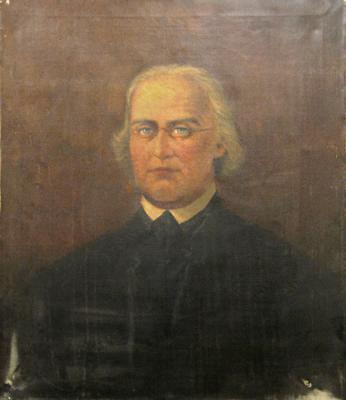President: 1791-1793
Fr. Robert Plunkett served as Georgetown's first president from 1791-1793. Plunkett's tenure featured the arrival of Georgetown's first students.
Early career
A secular seminarian in France, Fr. Robert Plunkett joined the Society of Jesus in 1769, but then left the order on August 21, 1773, six days after Pope Clement XIV issued an order suppressing the Jesuits. A few years later, Fr. Plunkett was ordained as a secular priest and received permission from Rome to travel as a missionary to America. In 1790, Fr. Plunkett sailed to America with Fr. Charles Neale and four nuns hoping to form a new convent. Upon arriving, Fr. Plunkett was assigned to the Jesuit plantation in White Marsh, Maryland.1
Meanwhile, having founded Georgetown in 1789, Bishop John Carroll sought someone to assume the role of Georgetown's President. After Fr. Robert Molyneux and Fr. Charles Plowden, two English ex-Jesuits refused the position, Bishop Carroll turned to Fr. Plunkett, and in 1791, Fr. Plunkett became Georgetown’s first president.2
First students
When Fr. Plunkett arrived at Georgetown, he found the academy under construction and still preparing to open. William Gaston, Georgetown’s first student, had arrived in early 1791 but found the college unprepared to open at the time. Gaston remained in Philadelphia under the instruction of Fr. Francis Fleming for the next several months studying French, English, and Latin. In October, Fr. Plunkett hired Georgetown’s first professor, Jean-Edouard de Mondésir, a seminarian from France. Mondésir would teach French and Latin while Fr. Plunkett worked to teach Mondésir English.3 Bishop Carroll encouraged Fr. Plunkett to prioritize seminarians for Georgetown’s faculty because Georgetown could pay them around half of the average college or academy salary.
In November 1791, Gaston returned to Georgetown, but with the college building, known later as Old South, still unfinished, he lived at the City Tavern. In December, Georgetown’s second student, Philemon Charles Wederstrandt, arrived, and Georgetown began teaching a class of two on January 2, 1792. Classes were held in Old South, and the curriculum included reading, writing, Latin, English grammar, arithmetic, geography, and French.
Growing enrollment
Stipulating that only those eight years of age or older who had learned to read and write would be admitted, Bishop Carroll urged Catholic families around the country to enroll their sons at Georgetown. By June 1792, enrollment had increased to forty students, not only from Maryland but New York, Virginia, Philadelphia, and the West Indies. In order to accommodate these students, Fr. Plunkett oversaw the expansion of Old South to extend an extra 130 feet and include a third story.4
During these first few years, students continued to board at homes in town rather than at the college, with professors visiting often to keep students busy and out of trouble. In November 1792, the American clergy met at White Marsh and approved a new building for the school which would provide additional study space, a hall, and dormitories. Construction began shortly thereafter, but what would become New North would not be completed until 1795.5
However, after only eighteen months as President and with Georgetown officially open, Fr. Plunkett hoped to return to his missionary work at White Marsh. With Bishop Carroll finally able to persuade Fr. Molyneux to fill the role, Fr. Plunkett’s presidency ended on June 14, 1793.
- 1Emmett Curran, Robert. “The Bicentennial History of Georgetown University: From Academy to University, 1789–1889.” 1993, pp.31-32.
- 2Daley, John. “Georgetown University: Origin and Early Years.” 1957, p.61.
- 3Id. at p.68.
- 4“The Bicentennial History of Georgetown University: From Academy to University, 1789–1889,” p.34.
- 5Georgetown University (Washington, DC), Ye Domesday Booke, 1964, pp. 5-6.



